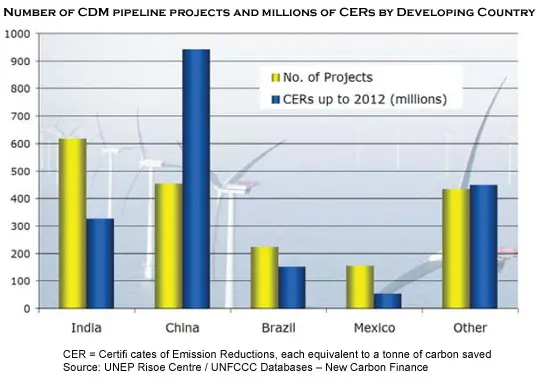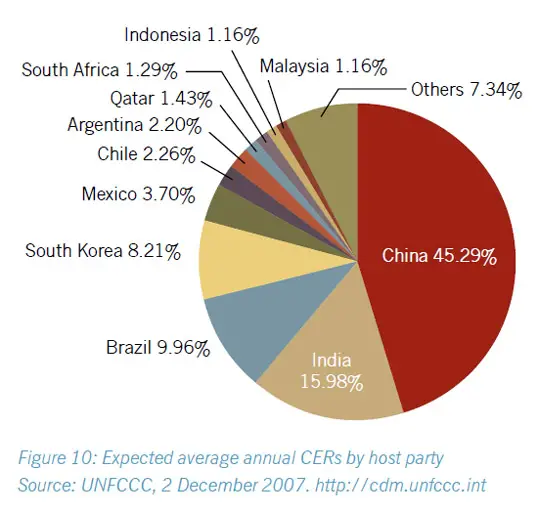The Clean Development Mechanism CDM was launched in 2001 and was designed as an international market mechanism that engages developing countries. It is designed to function as an incentive mechanism to promote emission reduction projects in developing countries. Annex I countries can use project-based emissions reduction credits from projects that are undertaken in Non-Annex I countries to count towards their emissions reduction targets. The credits generated are referred to as CERs.

Only projects that were begun after 1 January 2000 are eligible for generating and then obtaining CERs from a CDM project and it is essential that a CDM project meets the three criteria to qualify:
• It must show real, measurable and long-term benefits related to the mitigation of climate change;
• It must result in emission reductions that are “additional” to the baseline emissions that would occur in the absence of the project. This is often the most difficult criterion to meet; and
• It must contribute to sustainable development in the Non-Annex I country, where the project occurs. It is the responsibility of the Non-Annex I country to determine if a project satisfies this criterion. Thus, host countries for CDM projects must set procedures for reviewing and approving them. The procedures, such as those in China, are considered overly cumbersome.
The Clean Development Mechanism market has seen steady growth. One of the prime interests of developing countries in CDM is its potential to facilitate the transfer of clean technologies. China is the largest supplier of CERs with 64% of all CERs to be generated in Asia by 2012. As for projects currently in the pipeline, about 53% of all CERs expected to be generated in the world up until 2012 will come from China. Other significant CER suppliers have been India, Brazil and South Korea.

The Clean Development Mechanism was not originally designed to achieve an overall global emissions reduction, but to transfer emissions from developing to developed countries. The result to date has shown that the greatest involvement in CDM, measured by the number of projects, has been in the wind power sector. However, in terms of numbers of CERs, decomposition of industrial gases, such as HFC-23 , and methane capture-destruction projects have made up the greatest proportion of projects.
Clean Development Mechanism projects which have occurred in China, are attractive to the market because they offer the greatest CO2e savings for the least investment. They are also easy to show additionality given the fact that there is no useful by-product (e.g., electricity) and thus show the project would not have gone ahead without the CDM. This has led to the criticism that these projects merely prolonged the life of plants that should have been retired. Questions have arisen as to whether the Clean Development Mechanism was misconceived in the first place and should be abandoned after the first commitment period.
Suggestions have also been made as to how it could be reformed and made optimal to reduce global emissions (not transfer emissions). Thus: The additionality criterion could be removed and the CDM scheme could be linked to SD-PAMs projects, which will allow more projects to qualify and will permit more funds to flow from Annex I to non-Annex I countries; The mechanism could be redesigned to generate net global emission reduction by introducing CER discounting. CER discounting means that only a certain percentage of credits generated by a CDM project in a developing country would be sold to developed countries. This percentage could change based on the type of project or technology used. The credits that were not sold would be the amount of the total reduction; and Procedures could be streamlined.
China has recently developed a CDM Fund that will re-invest money generated from CDM projects into other domestic climate change initiatives. The fund has been designed to move in the above mentioned direction. The attraction of reforming the CDM mechanism is that it can be revised at the UNFCCC COP in Bali or at the COP in 2009, as changing the details of how it works does not require the Kyoto Protocol to be amended, only the authorisation of the CDM Executive Board.
Joint Implementation
JI is similar to CDM, except that the project-based emission reduction credits come from projects that are undertaken in other Annex I countries rather than Non-Annex I countries. JI projects can only generate credits between 2 008 and 2 012. So far, Russia and the Ukraine are the dominant potential players, accounting for about 70% of the projects in the pipeline, most of which are aimed at reducing leakage of methane from the Russian gas distribution systems. As the scheme has not started operation yet, it remains uncertain the extent to which these and other countries will enter the market.
Source: An Asian Stir Fry of Options, 2007, Christine Loh, Civic Exchange; Simon Tay, Singapore Institute of International Affairs; Andrew Stevenson, Civic Exchange; Carissa Yuk, Civic Exchange; Phir Paungmalit, Singapore Institute of International Affairs.
